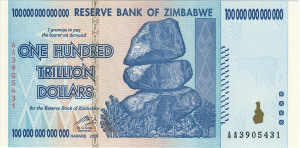One of the joys of teaching economics is pointing out the foolishness of poor economic choices. It is precisely by showing the linkage between cause and effect and demonstrating unintended consequences that helps students understand “the economic way of thinking.” As a monetary economist, there is perhaps no better visual aid than passing around an actual $100 Trillion Zimbabwe note. These notes were basically worthless at the end of Zimbabwe’s hyperinflation in 2008-2009. Yet I gladly paid $5 including shipping for my copy off ebay several years ago. I had to have one!
In today’s news Zimbabwe is officially ending their former currency era. Zimbabwe citizens can exchange each of their $100T notes for about 40 cents U.S.*
Zimbabweans will start exchanging “quadrillions” of local dollars for a few U.S. dollars next week, as President Robert Mugabe’s government discards its virtually worthless national currency, the central bank said on Thursday. The southern African country started using foreign currencies like the U.S. dollar and South African rand in 2009 after the Zimbabwean dollar was ruined by hyperinflation, which hit 500 billion percent in 2008.
Hyperinflation is in some ways the “long run” of inflation, yet in the most important way it is drastically different. Many doom and gloomers have said that the Fed’s malfeasance will lead to hyperinflation in the U.S. I’ve tried to avoid that talk, even though it is a possibility, because the Fed’s role if and when we ever have a hyperinflation is indirect. The cause of hyperinflation is always and everywhere a fiscal problem, and not at root a monetary problem. Hyperinflations occur when the government is no longer able to achieve its revenue goals for desired spending and chooses to directly print money. At the end of Zimbabwe’s run, they were generating ~10% of their spending in tax revenue, the rest of the spending was via the printing press.
So those worried about hyperinflation should not look at the Fed, but rather they should look at profligate politicians’ spending–that is the risk we face. I have far different complaints as to what the Fed’s poor policy choices will do, but hyperinflation is not at the top of the list. Nevertheless, one of the key problems of the Fed’s zero interest rate policy is that it has made it very easy for the political class to borrow and spend–thereby increasing the possibility that one day we will have to resort to mass money printing for financing of the government. Zimbabwe and Greece are warnings we should not ignore.
* Perhaps they should sell them on ebay?! Talk about inflation. I see copies today for about $30 on ebay. They originate out of China. Who thinks they are actually Zim notes?

 Bert Wheeler
Bert Wheeler
 Jeff Haymond
Jeff Haymond
 Marc Clauson
Marc Clauson
 Mark Caleb Smith
Mark Caleb Smith
 Tom Mach
Tom Mach